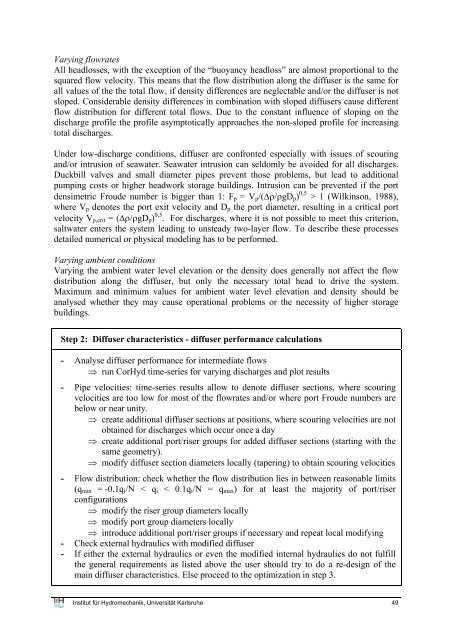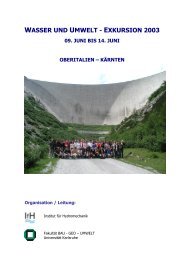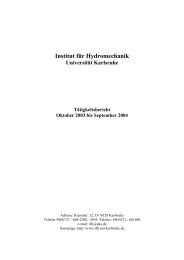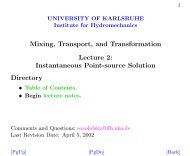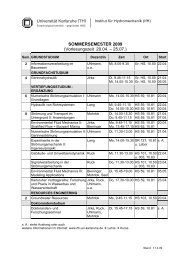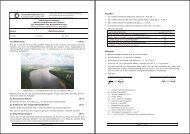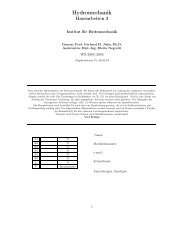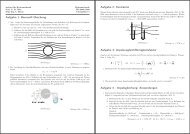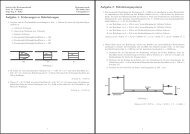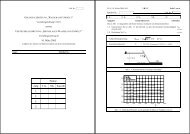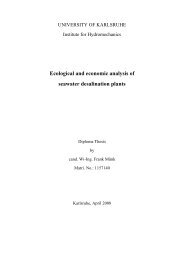user's manual for corhyd: an internal diffuser hydraulics model - IfH
user's manual for corhyd: an internal diffuser hydraulics model - IfH
user's manual for corhyd: an internal diffuser hydraulics model - IfH
You also want an ePaper? Increase the reach of your titles
YUMPU automatically turns print PDFs into web optimized ePapers that Google loves.
Varying flowrates<br />
All headlosses, with the exception of the “buoy<strong>an</strong>cy headloss” are almost proportional to the<br />
squared flow velocity. This me<strong>an</strong>s that the flow distribution along the <strong>diffuser</strong> is the same <strong>for</strong><br />
all values of the the total flow, if density differences are neglectable <strong>an</strong>d/or the <strong>diffuser</strong> is not<br />
sloped. Considerable density differences in combination with sloped <strong>diffuser</strong>s cause different<br />
flow distribution <strong>for</strong> different total flows. Due to the const<strong>an</strong>t influence of sloping on the<br />
discharge profile the profile asymptotically approaches the non-sloped profile <strong>for</strong> increasing<br />
total discharges.<br />
Under low-discharge conditions, <strong>diffuser</strong> are confronted especially with issues of scouring<br />
<strong>an</strong>d/or intrusion of seawater. Seawater intrusion c<strong>an</strong> seldomly be avoided <strong>for</strong> all discharges.<br />
Duckbill valves <strong>an</strong>d small diameter pipes prevent those problems, but lead to additional<br />
pumping costs or higher headwork storage buildings. Intrusion c<strong>an</strong> be prevented if the port<br />
densimetric Froude number is bigger th<strong>an</strong> 1: F p = V p /(∆ρ/ρgD p ) 0,5 > 1 (Wilkinson, 1988),<br />
where V p denotes the port exit velocity <strong>an</strong>d D p the port diameter, resulting in a critical port<br />
velocity V p,crit = (∆ρ/ρgD p ) 0,5 . For discharges, where it is not possible to meet this criterion,<br />
saltwater enters the system leading to unsteady two-layer flow. To describe these processes<br />
detailed numerical or physical <strong>model</strong>ing has to be per<strong>for</strong>med.<br />
Varying ambient conditions<br />
Varying the ambient water level elevation or the density does generally not affect the flow<br />
distribution along the <strong>diffuser</strong>, but only the necessary total head to drive the system.<br />
Maximum <strong>an</strong>d minimum values <strong>for</strong> ambient water level elevation <strong>an</strong>d density should be<br />
<strong>an</strong>alysed whether they may cause operational problems or the necessity of higher storage<br />
buildings.<br />
Step 2: Diffuser characteristics - <strong>diffuser</strong> per<strong>for</strong>m<strong>an</strong>ce calculations<br />
- Analyse <strong>diffuser</strong> per<strong>for</strong>m<strong>an</strong>ce <strong>for</strong> intermediate flows<br />
⇒ run CorHyd time-series <strong>for</strong> varying discharges <strong>an</strong>d plot results<br />
- Pipe velocities: time-series results allow to denote <strong>diffuser</strong> sections, where scouring<br />
velocities are too low <strong>for</strong> most of the flowrates <strong>an</strong>d/or where port Froude numbers are<br />
below or near unity.<br />
⇒ create additional <strong>diffuser</strong> sections at positions, where scouring velocities are not<br />
obtained <strong>for</strong> discharges which occur once a day<br />
⇒ create additional port/riser groups <strong>for</strong> added <strong>diffuser</strong> sections (starting with the<br />
same geometry).<br />
⇒ modify <strong>diffuser</strong> section diameters locally (tapering) to obtain scouring velocities<br />
- Flow distribution: check whether the flow distribution lies in between reasonable limits<br />
(q min = -0.1q i /N < q i < 0.1q i /N = q max ) <strong>for</strong> at least the majority of port/riser<br />
configurations<br />
⇒ modify the riser group diameters locally<br />
⇒ modify port group diameters locally<br />
⇒ introduce additional port/riser groups if necessary <strong>an</strong>d repeat local modifying<br />
- Check external <strong>hydraulics</strong> with modified <strong>diffuser</strong><br />
- If either the external <strong>hydraulics</strong> or even the modified <strong>internal</strong> <strong>hydraulics</strong> do not fulfill<br />
the general requirements as listed above the user should try to do a re-design of the<br />
main <strong>diffuser</strong> characteristics. Else proceed to the optimization in step 3.<br />
Institut für Hydromech<strong>an</strong>ik, Universität Karlsruhe 49


